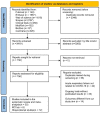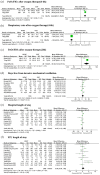Comparison between high-flow nasal cannula and conventional oxygen therapy in COVID-19 patients: a systematic review and meta-analysis
- PMID: 38230522
- PMCID: PMC10798115
- DOI: 10.1177/17534666231225323
Comparison between high-flow nasal cannula and conventional oxygen therapy in COVID-19 patients: a systematic review and meta-analysis
Abstract
Background: High-flow nasal cannula (HFNC) and conventional oxygen therapy (COT) are important respiratory support strategies for acute hypoxemic respiratory failure (AHRF) in coronavirus disease 2019 (COVID-19) patients. However, the results are conflicting for the risk of intubation with HFNC as compared to COT.
Objectives: We systematically synthesized the outcomes of HFNC relative to COT in COVID-19 patients with AHRF and evaluated these outcomes in relevant subpopulations.
Design: This study was designed in accordance with Preferred Reporting Items for Systematic Reviews and Meta-Analyses guidelines.
Data sources and methods: We searched PubMed, EMBASE, Web of Science, Scopus, ClinicalTrials.gov, medRxiv, BioRxiv, and the Cochrane Central Register of Controlled Trials for randomized controlled trials and observational studies that compared the efficacy of HFNC with COT in patients with COVID-19-related AHRF. Primary outcomes were intubation rate and mortality rate. Secondary outcomes were the ratio of arterial oxygen partial pressure to fractional inspired oxygen (PaO2/FiO2), respiratory rate, hospital length of stay, intensive care unit (ICU) length of stay, and days free from invasive mechanical ventilation.
Results: In total, 20 studies with 5732 patients were included. We found a decreased risk of requiring intubation in HFNC compared to COT [odds ratio (OR) = 0.61, 95% confidence interval (CI): 0.46-0.82, p = 0.0009, I2 = 75%]. Similarly, we found HFNC was associated with lower risk of intubation rate compared to COT in the subgroup of patients with baseline PaO2/FiO2 < 200 mmHg (OR = 0.69, 95% CI: 0.55-0.86, p = 0.0007, I2 = 45%), and who were in ICU settings at enrollment (OR = 0.57, 95% CI: 0.38-0.85, p = 0.005, I2 = 80%). HFNC was associated with an improvement of PaO2/FiO2 and respiratory rate compared to COT. The use of HFNC compared to COT did not reduce the mortality rate, days free from invasive mechanical ventilation, hospital length of stay, or ICU length of stay.
Conclusion: Compared to COT, HFNC may decrease the need for tracheal intubation in patients with COVID-19-related AHRF, particularly among patients with baseline PaO2/FiO2 < 200 mmHg and those in ICU settings.
Trial registration: This systematic review and meta-analysis protocol was prospectively registered with PROSPERO (no. CRD42022339072).
Keywords: COVID-19; conventional oxygen therapy; high-flow nasal cannula.
Conflict of interest statement
The authors declare that there is no conflict of interest.
Figures





Similar articles
-
Comparison between high-flow nasal cannula and noninvasive ventilation in COVID-19 patients: a systematic review and meta-analysis.Ther Adv Respir Dis. 2022 Jan-Dec;16:17534666221113663. doi: 10.1177/17534666221113663. Ther Adv Respir Dis. 2022. PMID: 35861299 Free PMC article.
-
Comparison of High Flow Nasal Therapy with Non-Invasive Ventilation and Conventional Oxygen Therapy for Acute Hypercapnic Respiratory Failure: A Meta-Analysis of Randomized Controlled Trials.Int J Chron Obstruct Pulmon Dis. 2023 May 22;18:955-973. doi: 10.2147/COPD.S410958. eCollection 2023. Int J Chron Obstruct Pulmon Dis. 2023. PMID: 37251703 Free PMC article. Review.
-
High-flow nasal cannula reduces intubation rate in patients with COVID-19 with acute respiratory failure: a meta-analysis and systematic review.BMJ Open. 2023 Mar 30;13(3):e067879. doi: 10.1136/bmjopen-2022-067879. BMJ Open. 2023. PMID: 36997243 Free PMC article.
-
High-flow nasal cannula oxygen therapy is superior to conventional oxygen therapy but not to noninvasive mechanical ventilation on intubation rate: a systematic review and meta-analysis.Crit Care. 2017 Jul 12;21(1):184. doi: 10.1186/s13054-017-1760-8. Crit Care. 2017. PMID: 28701227 Free PMC article.
-
High-flow nasal cannulae for respiratory support in adult intensive care patients.Cochrane Database Syst Rev. 2021 Mar 4;3(3):CD010172. doi: 10.1002/14651858.CD010172.pub3. Cochrane Database Syst Rev. 2021. PMID: 33661521 Free PMC article.
Cited by
-
Predictors of high-flow nasal cannula failure in COVID-19 patients in a northern Peruvian hospital.BMC Pulm Med. 2024 Aug 28;24(1):414. doi: 10.1186/s12890-024-03241-0. BMC Pulm Med. 2024. PMID: 39198776 Free PMC article.
-
Efficacy of High Flow Nasal Cannula in the Treatment of Patients with COVID-19 with Acute Respiratory Distress Syndrome: Results of Single Centre Study in Vietnam.Pulm Ther. 2024 Dec;10(4):451-468. doi: 10.1007/s41030-024-00272-0. Epub 2024 Oct 18. Pulm Ther. 2024. PMID: 39422832 Free PMC article.
-
Implementing Oxygen Therapy in Medical Wards-A Scoping Review to Understand Health Services Protocols and Procedures.J Clin Med. 2024 Sep 18;13(18):5506. doi: 10.3390/jcm13185506. J Clin Med. 2024. PMID: 39336993 Free PMC article.
-
High-Flow Oxygen Therapy as the Cause of Oxygen Scarcity: The Limitations of Lumping and the Curse of Complexity.Respir Care. 2024 Jul 24;69(8):1062-1070. doi: 10.4187/respcare.12163. Respir Care. 2024. PMID: 39048150 Free PMC article. No abstract available.
References
Publication types
MeSH terms
Substances
LinkOut - more resources
Full Text Sources
Medical
Miscellaneous

